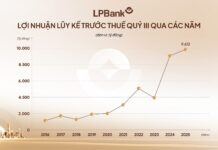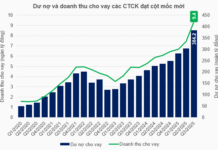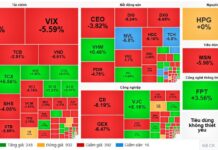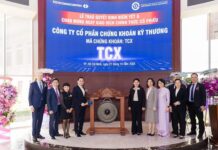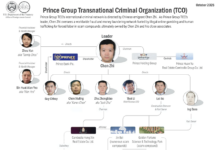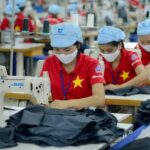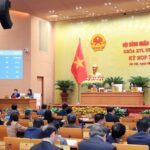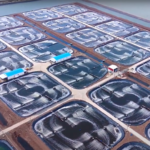The Evolution of Vietnam’s Textile Industry: Embracing Sustainability for Long-Term Success

|
Vietnam’s textile industry has come a long way, establishing itself as a pivotal link in the global textile supply chain through relentless efforts. This sector contributes significantly to the country’s foreign exchange earnings and provides livelihoods for approximately three million workers.
However, to maintain its stronghold in the face of intensifying competition, it is imperative for the industry to recognize its current standing, adopt a proactive and flexible approach, and implement synchronized solutions. By doing so, it can enhance its competitiveness and embark on a path of sustainable development in this new era of national advancement.
The year 2024 marked a notable recovery for the Vietnamese textile industry, setting a solid foundation and instilling confidence for the sector to pursue its strategic development goals for 2025 and beyond—an era of national aspiration and growth.
Yet, alongside its strengths, the industry also faces inherent weaknesses. A clear understanding of the industry’s landscape will enable Vietnamese textile businesses to accurately position and assess their situation, thereby charting a suitable course of action to enhance their competitiveness and foster sustainable growth.
## Overcoming Challenges
The rise of conscious consumerism and the push for sustainable practices present significant challenges for textile businesses. A recent Roundup organization survey revealed that 73% of men aged 25-34 are willing to spend more on sustainable fashion. Additionally, 69% of Vogue magazine readers consider sustainability a crucial factor in their purchasing decisions. This shift in consumer behavior has led to a 46% decline in fast-fashion retailers’ sales since 2020, with 85% of prominent fashion brands committing to sustainability goals and roadmaps.
Adidas, for instance, has pledged to use 100% recycled materials and reduce carbon emissions by 90% by 2025. Similarly, Nike aims for 100% renewable energy use by 2025 and carbon neutrality by 2030.
Mr. Vo Thanh Phuoc, Development Director of Faslink Fashion Connection Company, highlighted that in the next 2-4 years, the textile industry will have to navigate over 35 new laws related to sustainability across major markets like the US, EU, Japan, China, and India. Failure to meet these market demands could result in lost orders and decreased revenue for businesses.
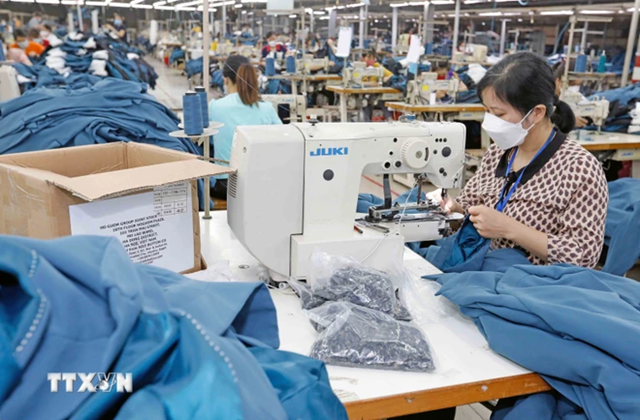
|
Ms. Nguyen Thi Thuy, Regional Sales Manager for Southeast Asia at Lloyds Register Group, pointed out that environmental concerns and overtime work are significant risks for Vietnamese export industries, including textiles. Leading fashion brands like Adidas, Nike, Puma, and Reebok require their supply chains to provide data on international platforms such as SBTi, Higg FEM, ZDHC, and SLCP to support their sustainability goals.
Despite a recovery in orders and export value this year, the textile industry continues to face challenges. According to Ms. Duong Thuy Linh, Vice Secretary-General of the Vietnam Cotton and Spinning Association (VCOSA), while orders have increased, the quantity per order has decreased. Prices remain at last year’s levels, and the short delivery timeframes coupled with high production costs to meet market standards pose significant challenges.
Moreover, the industry still heavily relies on imported raw materials and accessories. Mr. Chris Walker, a sourcing expert from the Vietnam Factory Tours program, noted that Vietnam produces only 1% of its cotton fiber requirements, importing approximately $3 billion worth of this material. For synthetic fibers, the figures stand at 30% and $2 billion, respectively, while for fabric, it’s 20% and $13 billion.
Mr. Tran Linh, Production Manager at Adidas Sourcing Vietnam, added that Vietnam imports about 64% of its fabric and 99% of its cotton. Adidas, too, relies mostly on imports from China for its raw materials used in Vietnam’s textile production. This dependence on a limited number of suppliers leaves the industry vulnerable to geopolitical tensions, squeezing profit margins and threatening sustainability.
## Advancing in the Value Chain
The industry has yet to move up the value chain, as evidenced by the predominance of CMT (cut-make-trim) exports, which account for approximately 65% of the total. OEM/FOB (original equipment manufacturer/free on board) exports make up around 25%, while only 10% are ODM (original design manufacturer) or private-label exports, with CMT having the lowest profit margins of 1-3%. In contrast, ODM can achieve margins of 5-7%, while OBM (original brand manufacturer) surpasses 10%.
The lack of control over the supply chain also hinders businesses’ ability to provide transparency in their production processes. Mr. Colin Luk, founder of VeriCott, mentioned consumer boycotts of brands like Zara, Gap, and Muji due to concerns over unreliable cotton sources.
Additionally, Vietnam’s labor costs are no longer as competitive compared to other countries. According to the International Labor Organization, the average monthly wage for textile workers in Vietnam is around $300, higher than the global average and significantly more than that of India and Bangladesh. The upcoming 6% increase in the regional minimum wage, effective July 1, 2024, will further impact businesses considering investment in Vietnam.
## Seizing New Opportunities
While the push for sustainability presents challenges, it also opens up new business opportunities. Mr. Phuoc noted that the global market for sustainable fashion is projected to reach approximately $7.07 billion in 2023 and is estimated to soar to $13.5 billion by 2031. This shift will drive the demand for sustainable raw materials to 133 million tons by 2030, with sustainable materials already accounting for 56% of the market share in 2023.
The average annual growth rate of this market exceeds 8.5%, with North America leading the way, accounting for 35.6% of the market, followed by the EU at 25.8%. The Asia-Pacific region is projected to be the fastest-growing market, with a remarkable growth rate of 16.5%.
Over five years, brands embracing sustainable practices have achieved a 6% increase in profits. According to Mr. Phuoc, 70-80% of Faslink’s customers show a strong interest in sustainable fashion products. The majority of foreign partners require 100% recycled or natural-origin materials, and all uniform customers insist on sustainable options. This indicates a substantial potential for green and sustainable fashion.
Vietnam’s economic advantages, bolstered by free trade agreements, continue to attract investors and spur business confidence. Ms. Linh highlighted optimistic forecasts from international financial institutions about Vietnam’s economy, including high GDP growth rates and attractive bank lending interest rates. Additionally, inflation in major export markets has eased, and inventory levels of major fashion brands have decreased, leading to a gradual recovery in consumer demand.
The significant shift of orders from China to Vietnam due to the UFLPA law and political unrest in Bangladesh has also played a role. The Vietnamese government has implemented supportive policies to enhance the supply chain, and FDI investors have increased fabric production in the country. Businesses are embracing green production strategies and adopting sustainability standards to increase value addition. There is also a growing demand for domestically branded fashion.
Mr. Huynh Thanh Dien, an economic expert, emphasized that the Asia-Pacific region, including Vietnam, remains attractive to investors. Vietnamese businesses possess a skilled and adaptable workforce, capable of embracing automation and digital management, and are transitioning from CMT to ODM production.
Ms. Thuy concurred, citing Vietnam’s favorable geographical location, political stability, and improving infrastructure. She also highlighted the industry’s young and abundant labor force, superior sewing skills compared to Indonesia, Bangladesh, and India, and the increasing adoption of sustainable practices by Vietnamese companies.
Mr. Walker added that several Vietnamese companies are already supplying raw materials to major brands like Adidas and Nike, meeting their stringent requirements. Furthermore, Vietnam is capable of producing eco-friendly fabrics, such as coffee-based fabric by Faslink and pineapple-based fabric by Bao Lan Company.
However, global economic uncertainties persist due to military conflicts, which pose a threat to the stability of supply chains worldwide. Mr. Dien cautioned that the military conflict between Russia and Ukraine and other regions remains perilous, underscoring the need for businesses to stay vigilant and adaptable.
Lâm Nguyên
The Textile Business: Market Rebound Yields Fruitful Exports
According to the Chairman of Vitas, the global scale growth for the textile industry in 2024 showed no significant transformation or remarkable growth. However, Vietnam witnessed a surge in growth by successfully riding the wave of order diversification.
“The Hanoi Target: Aiming for 6.5% Growth by 2025”
On December 10th, the Hanoi People’s Council, at its 20th session, passed a resolution on the city’s socio-economic development plan for 2025. The resolution sets an ambitious target of achieving a 6.5% growth rate in the regional gross domestic product (GRDP) while aiming for a per capita GRDP of 172.4 million VND.
The New Travel Trend: Exploring Domestic Destinations
A shift in travel preferences is evident, with 49% of Vietnamese travelers opting for domestic locations, while a remarkable 70% of Thai and Japanese tourists favor exploring their own countries.
Traveloka, the leading travel platform in Southeast Asia, has partnered with YouGov to unveil its latest research study titled, “Redefining Travel: Understanding and Catering to the Evolving Needs of APAC Travelers.”
‘Breaking’: Ministry Merger Proposal; Eye-Popping Lunar New Year Bonuses Revealed
Supplementing the estimated reform salary cost; details of the plan to organize the apparatus of the Ministry of Finance, the Ministry of Planning and Investment, and the Ministry of Industry and Trade; FDI enterprises defaulting on billions of dong in taxes and leaving the country; enterprises in Binh Duong province offering the highest Tet bonus of up to nearly 400 million VND/person… were notable information last week.








